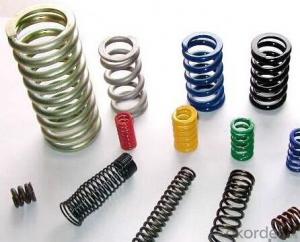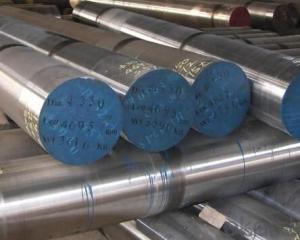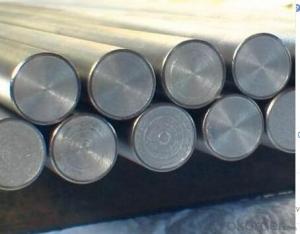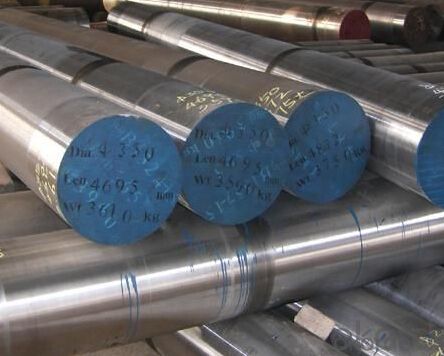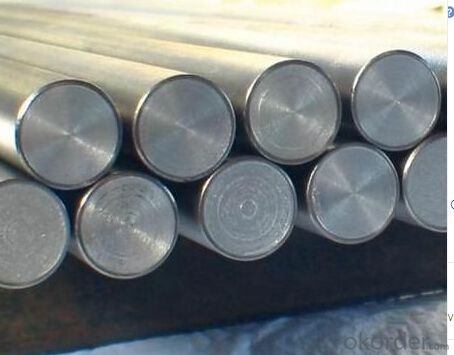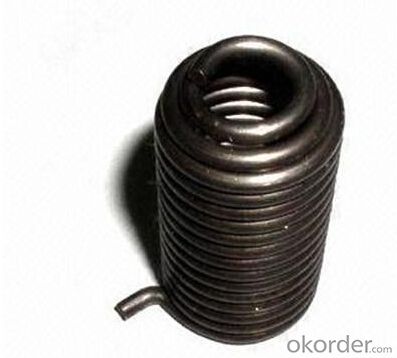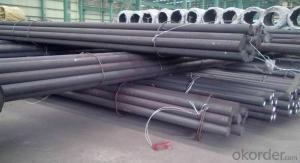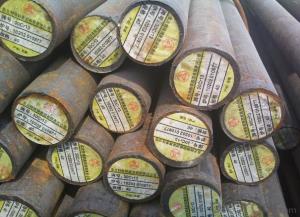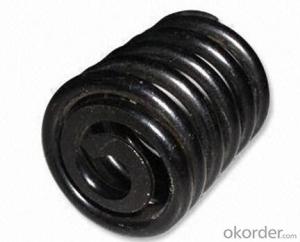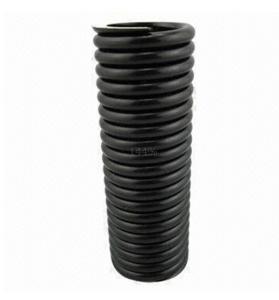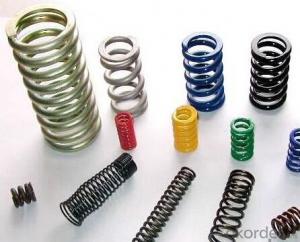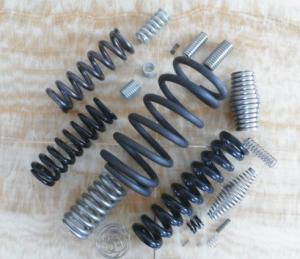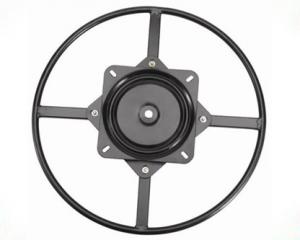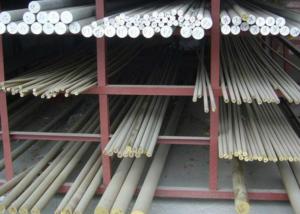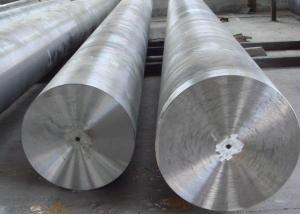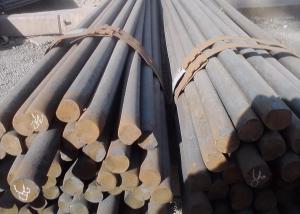Stainless Steel Compression Spring
- Loading Port:
- China Main Port
- Payment Terms:
- TT or LC
- Min Order Qty:
- -
- Supply Capability:
- -
OKorder Service Pledge
OKorder Financial Service
You Might Also Like
Product Description:
OKorder is offering Stainless Steel Compression Spring at great prices with worldwide shipping. Our supplier is a world-class manufacturer of steel, with our products utilized the world over. OKorder annually supplies products to European, North American and Asian markets. We provide quotations within 24 hours of receiving an inquiry and guarantee competitive prices.
Product Applications:
Stainless Steel Compression Spring are ideal for structural applications and are widely used in the construction of buildings and bridges, and the manufacturing, petrochemical, and transportation industries.
Product Advantages:
OKorder's Stainless Steel Compression Spring are durable, strong, and resist corrosion.
Main Product Features:
· Premium quality
· Prompt delivery & seaworthy packing (30 days after receiving deposit)
· Corrosion resistance
· Can be recycled and reused
· Mill test certification
· Professional Service
· Competitive pricing
Product Specifications:
Features of Heavy Duty Compression Spring:
1) Easily adjusted in coil diameter and pitch
2) Major materials: music wire, stainless
Features:
1) Easily adjusted in coil diameter and pitch
2) Major materials: music wire, stainless steel wire, oil tempered wire, spring steel
3) Different wire diameters, such as Ø4.0mm, 5.0mm, 8.0mm and 12.0mm
4)What kind of shape compression spring we can do for you?
Spring shape: Conical, Round and Rectangular, Hourglass, Barrel, Constant Pitch, Variable Pitch etc. see picture below
Product Information | |
product name | Heavy Duty Piston Compression Spring |
brand name | YD |
model number | YD009 |
certificate | ISO9001,RHOS |
material | carbon steel,alloy spring steel,music wire steel,and stainless steel,iron,plated steel,alloy steel,bronze,red bronze,phosphor copper,and beryllium copper;etc |
usage | car,all kinds of machines,motor,etc. |
galvanized | nickel-plated, chrome-plated, silver-plated, gold-plated, imitation gold-plated and so on or as your request |
package | all springs will be carefully packed and shipped to you with PE bags. |
payment | TT/LC |
shipment | all orders are dispatched within 7-10 business days by EMS, DHL or as your request after making payment.A Tracking Number will be sent to you via e-mail after your order has been shipped.If you do not receive the Tracking Number email within 7 business days of confirming payment, please check your spam folder and then contact us. |
PLEASE NOTE: Please allow 5-9 business days for your shipment to arrive. | |
FAQ:
Q1: Why buy Materials & Equipment from OKorder.com?
A1: All products offered byOKorder.com are carefully selected from China's most reliable manufacturing enterprises. Through its ISO certifications, OKorder.com adheres to the highest standards and a commitment to supply chain safety and customer satisfaction.
Q2: How do we guarantee the quality of our products?
A2: We have established an advanced quality management system which conducts strict quality tests at every step, from raw materials to the final product. At the same time, we provide extensive follow-up service assurances as required.
Q3: How soon can we receive the product after purchase?
A3: Within three days of placing an order, we will begin production. The specific shipping date is dependent upon international and government factors, but is typically 7 to 10 workdays.
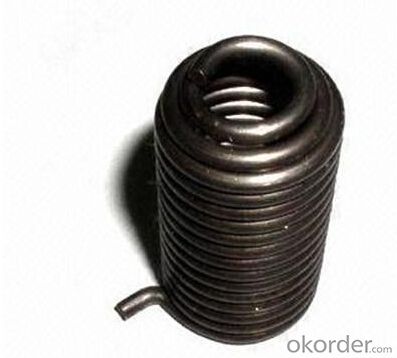

- Q:What are the recycling options for special steel?
- There are several recycling options available for special steel. One option is to take it to a local scrap yard or metal recycling facility. These facilities have the necessary equipment to process and recycle special steel. They will typically pay you for the steel based on its weight and current market value. Another option is to contact a specialized recycling company that deals specifically with special steel. These companies have expertise in handling and recycling this type of steel and can ensure that it is properly processed and reused. Additionally, some steel manufacturers and distributors have their own recycling programs in place. They may offer take-back programs where they will collect and recycle special steel from their customers. This can be a convenient option as it eliminates the need to find a separate recycling facility. It is important to note that special steel may require special handling and processing due to its unique properties. Therefore, it is recommended to consult with a professional or contact the recycling facility or company beforehand to ensure that they can properly handle and recycle the specific type of special steel you have.
- Q:How is stainless steel used in the production of kitchen utensils?
- Stainless steel is commonly used in the production of kitchen utensils due to its durability, resistance to corrosion, and easy maintenance. It is used to make a wide range of utensils such as knives, spoons, forks, and pots. The stainless steel material ensures that the utensils remain rust-free, food-safe, and long-lasting, making it ideal for daily cooking and food preparation.
- Q:Can special steel be used in the automotive racing industry?
- Yes, special steel can be used in the automotive racing industry. Special steel alloys, like high-strength steels or heat-resistant steels, are commonly utilized to enhance performance, durability, and safety in racing vehicles. These specialized steels offer superior strength-to-weight ratios, improved mechanical properties, and resistance to extreme temperatures, making them ideal for various automotive racing applications such as chassis, suspension components, engine parts, and exhaust systems.
- Q:Can special steel be used for making food processing equipment?
- Food processing equipment can indeed be made using special steel. Known as stainless steel, this type of steel is widely utilized in the food processing industry due to its distinctive characteristics. Stainless steel, being non-reactive, does not interact with food or change its taste, smell, or appearance. Furthermore, it is resistant to corrosion, a crucial feature in safeguarding against contamination and ensuring food safety. Additionally, special steel is long-lasting, easy to clean, and possesses a smooth surface that hinders bacterial growth. These attributes render it an excellent choice for producing food processing equipment such as mixing tanks, conveyors, cutting tools, and storage containers.
- Q:Is the steel column of the steel structure HM a special steel?
- Because the legs are parallel inside and outside, the legs are at right angles and are assembled and assembled into components to save welding and riveting, and the work load is 25%. Often used in large capacity requirements, large cross section stability, such as buildings, high-rise buildings, as well as bridges, ships, lifting transport machinery, equipment foundation, support, foundation piles.
- Q:How does precipitation hardening enhance the strength of special steel?
- Precipitation hardening, also known as age hardening, is a heat treatment process that enhances the strength of special steel alloys. This process involves a series of steps that result in the formation of fine particles or precipitates within the material's microstructure. The strength of special steel is primarily determined by the arrangement and interaction of its atoms. In its initial state, the alloy's atoms are distributed randomly, resulting in a relatively soft and ductile material. However, through precipitation hardening, the formation of precipitates during heat treatment plays a crucial role in strengthening the steel. The process begins by heating the steel to a high temperature, known as solution treatment or aging temperature. This temperature allows the atoms to dissolve and form a solid solution. The alloy is then rapidly cooled to retain the supersaturated state of the solution. Following the rapid cooling, the steel is subjected to a lower temperature, known as aging temperature. At this stage, the dissolved atoms begin to migrate and cluster together, forming small precipitates within the material's microstructure. These precipitates act as obstacles to the movement of dislocations, which are the primary carriers of plastic deformation in metals. The presence of these precipitates hinders the dislocation movement, making it more difficult for them to glide through the crystal lattice. As a result, the strength of the steel is significantly enhanced. The dislocation obstacles provided by the precipitates increase the resistance to deformation, resulting in improved hardness and strength. Furthermore, the size, distribution, and homogeneity of the precipitates play a crucial role in determining the strength enhancement. Smaller and more uniform precipitates provide a higher density of obstacles, leading to a greater strengthening effect. Additionally, the precipitation hardening process also influences other material properties, such as corrosion resistance and toughness. In conclusion, precipitation hardening enhances the strength of special steel by creating fine precipitates within the material's microstructure. These precipitates act as obstacles to dislocation movement, increasing the resistance to deformation and resulting in improved hardness and strength. This heat treatment process plays a crucial role in the development of high-performance special steel alloys used in various industries.
- Q:What are the applications of special steel in the oil and gas manufacturing process?
- Special steel has various applications in the oil and gas manufacturing process. It is commonly used in the construction of pipelines, offshore platforms, and equipment for drilling and extraction. Special steel's high strength and corrosion resistance properties make it ideal for handling the demanding conditions encountered in oil and gas operations. Additionally, it is used in the production of valves, pumps, and other critical components that require durability and reliability to ensure efficient and safe processes in the industry.
- Q:What are the different methods for annealing special steel?
- There are several methods for annealing special steel, each designed to achieve specific results and properties. Some of the most commonly used methods include: 1. Full annealing: This method involves heating the steel to a temperature above its critical temperature and holding it there for a specific duration of time. It is then slowly cooled to room temperature. Full annealing helps to achieve maximum softness and improve ductility, making the steel easier to machine and work with. 2. Isothermal annealing: In this method, the steel is heated to a temperature above its critical temperature and then immediately transferred to a furnace or chamber where it is held at a constant temperature. This allows for controlled cooling, resulting in a homogeneous and fine-grained microstructure. Isothermal annealing is particularly useful for reducing distortion and improving dimensional stability in complex-shaped parts. 3. Spheroidize annealing: This method is commonly used for high-carbon steels. It involves heating the steel to a temperature just below its critical temperature and holding it there for an extended period. This promotes the formation of spheroidized carbides, which improves machinability and reduces brittleness. 4. Process annealing: This method is typically employed to relieve internal stresses and reduce hardness in cold-worked steel. The steel is heated to a temperature below its critical temperature and then cooled in still air. Process annealing helps to restore ductility and improve formability. 5. Stress-relief annealing: This method is used to alleviate residual stresses in the steel, often caused by welding or machining processes. The steel is heated to a temperature below its critical temperature and then slowly cooled. Stress-relief annealing helps to minimize distortion and prevent cracking. It is important to note that the specific annealing method used for special steel will depend on factors such as the composition of the steel, desired mechanical properties, and the intended application of the material.
- Q:Can special steel be used in the production of artistic sculptures?
- Yes, special steel can definitely be used in the production of artistic sculptures. Special steel, which refers to steel alloys that have been specifically designed and manufactured for particular applications, offers a wide range of advantages that make it suitable for creating sculptures. Firstly, special steel alloys provide exceptional strength and durability, allowing sculptors to create large and intricate structures that can withstand external forces and environmental conditions. This strength and resilience is crucial, especially for outdoor sculptures that are exposed to weather elements such as rain, wind, and extreme temperatures. Additionally, special steel alloys offer versatility in terms of shaping and forming. They can be easily molded and manipulated into various shapes and sizes, which allows artists to bring their creative visions to life. Sculptors can utilize different techniques such as welding, cutting, and bending to shape the steel into their desired forms, enabling them to create unique and captivating sculptures. Moreover, special steel alloys can be finished in various ways, such as polishing, painting, or coating, to enhance their aesthetic appeal. This allows artists to add different textures, colors, and surface finishes to their sculptures, further enhancing their artistic value. Furthermore, special steel alloys can also provide resistance to corrosion, which is particularly important for sculptures that are placed in outdoor or humid environments. This corrosion resistance ensures that the sculptures retain their visual appeal and structural integrity over time, reducing the need for frequent maintenance and repairs. In conclusion, special steel offers a wide range of advantages that make it an excellent choice for the production of artistic sculptures. Its strength, versatility, aesthetic appeal, and resistance to corrosion provide artists with the necessary tools to create visually stunning and durable sculptures that can be enjoyed for years to come.
- Q:How is wear-resistant tool steel used in the production of cutting tools?
- Wear-resistant tool steel is commonly used in the production of cutting tools due to its high hardness and resistance to wear. This steel is able to withstand the abrasive forces and high temperatures generated during cutting operations, resulting in longer tool life and improved cutting performance. The wear-resistant tool steel is typically used to manufacture various cutting tools such as drills, milling cutters, saw blades, and lathe tools, ensuring durability and efficiency in metalworking and machining processes.
1. Manufacturer Overview |
|
|---|---|
| Location | |
| Year Established | |
| Annual Output Value | |
| Main Markets | |
| Company Certifications | |
2. Manufacturer Certificates |
|
|---|---|
| a) Certification Name | |
| Range | |
| Reference | |
| Validity Period | |
3. Manufacturer Capability |
|
|---|---|
| a)Trade Capacity | |
| Nearest Port | |
| Export Percentage | |
| No.of Employees in Trade Department | |
| Language Spoken: | |
| b)Factory Information | |
| Factory Size: | |
| No. of Production Lines | |
| Contract Manufacturing | |
| Product Price Range | |
Send your message to us
Stainless Steel Compression Spring
- Loading Port:
- China Main Port
- Payment Terms:
- TT or LC
- Min Order Qty:
- -
- Supply Capability:
- -
OKorder Service Pledge
OKorder Financial Service
Similar products
Hot products
Hot Searches
Related keywords
